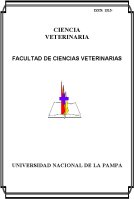Evaluación de la efectividad de una vacuna contra Mastitis por staphylococus aureus streptococus agalactiae en vacas lecheras
Keywords:
Mastitis, Dairy herd, Vaccine, Staphylococcus aureusAbstract
Mastitis is a problematic infectious disease that affect the mammary gland of dairy cattle with negatives consequence upon milk quality and production. Genus of bacteria such as Staphylococcus and Streptococcus are responsible for more than 90% of mastitis cases. he objective of this work was to test the effect of a Staphylococcus aureus and Streptococcus agalactiae killed vaccine upon the disease incidence of the aforementioned bacteria and milk production during the first four months of lactation ina Holstein dairy herd. Sixty two heifers were randomly divided into two groups: T1(control) and T2 (treatment).All of the animals calved in autumn. During theexperimental period were discarded six animals, hence the groups were composed for 28 animals. The T2 animals received two subcutaneous doses, 40 and 7 days prepartum of a Staphylococcus aureus and Streptococcus agalactiae killed vaccine (Redumast, Biotay Lab.). The T1 and T2 groups were bacteriological sampled four times from each quarter with intervals of three weeks, and were also registered the milk yield during the first four month of lactation. The Staphylococcus aureus positive isolation was 5.14 % in T1 and 2.34 % in T2, whereas Streptococcus agalactiae showed a positive isolation of 6.54 % in T1 and 3.04 % in T2.The effect of vaccination was statistically significant(p0,05) in both groups. On the other hand, the Somatic Cell Count (SCC) was higher in the treatment group (257,622 cells/ml) than in the control group (157,256 cells/ml), whereas the milk yield was similar in both groups. The vaccine employed in this work was effective in reduce the incidence of Staphylococcus aureus and Streptococcus agalactiae subclinical infection in 45.5 % and 46.5 % respectively, without any effect upon milk production during the first four months of lactation (T1: 14.17 +- 5.14 and T2: 13.52 +- 4.22). Nevertheless, more research should be done in this field, in order to elucidate the contradictory response in SCCDownloads
Downloads
Published
How to Cite
Issue
Section
License
Al momento de enviar sus contribuciones, los colaboradores deberán declarar , de manera fehaciente, que poseen el permiso del archivo o repositorio donde se obtuvieron los documentos que se anexan al trabajo, cualquiera sea su formato (manuscritos inéditos, imágenes, archivos audiovisuales, etc.), permiso que los autoriza a publicarlos y reproducirlos, liberando a la revista y sus editores de toda responsabilidad o reclamo de terceros , los autores deben adherir a la licencia Creative Commons denominada “Atribución - No Comercial CC BY-NC-SA”, mediante la cual el autor permite copiar, reproducir, distribuir, comunicar públicamente la obra y generar obras derivadas, siempre y cuando se cite y reconozca al autor original. No se permite, sin embargo, utilizar la obra con fines comerciales.



4.png)


7.png)



